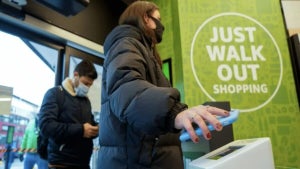These days, there are a lot of Google Maps scams that we need to worry about. The more Google Maps is useful for business, the more we’ll see scammers trying to take advantage of users heading there to find a product or service they need. We have to be careful.

We’ve seen Google Maps banking scams and we’ve seen false competitions offering fake prizes to try and trick us into handing over private and sensitive information. Unfortunately, it doesn’t end there.
A new report from The Wall Street Journal highlights a brand-new trick that we need to look out for. Fake business profiles. We now have to look out for false Google Maps business listings from fake companies. You can read more about this new type of scam here but for now, we want to show you how to stay safe on Google Maps when searching for a local business.
How to find businesses on Google Maps
The two most common ways of finding businesses on Google Maps are via the Google search bar or by searching for them directly on Google Maps.
As Google’s search has evolved, results pages have become more and more advanced. Now, when searching for a particular business or type of business you don’t just receive a list of potential matches for your query. Instead, you’re also shown a map widget; clicking this widget will open Google Maps. You can then click on the business profiles of the businesses matching your query. This works both on desktop and on mobile.

You can cut out the above step altogether by searching directly in Google Maps. Again, this can be done on both mobile and desktop devices and will show you a list of business profiles complete with dots showing their location on your map.

A very Google problem
Google claims to have a rigorous vetting process to prevent fake businesses from being verified and finding their way onto Google Maps. Unfortunately, this doesn’t stop them all and quite a few get through. This means that you are your own strongest weapon in the battle to keep yourself safe.
Google Maps’ fake business problem is a little like the Google Play Store’s fake app problem. There are too many submissions for them all to be verified individually and some scams break through the automated defenses. This means we can take a little of what we’ve learned from staying safe on the Google Play Store and use it to help us stay safe when looking for businesses on Google Maps.

How to detect fake apps in the Google Play Store in just 3 steps
Read nowHow to spot fake businesses on Google Maps
There are a few rules we can follow to try and stay safe on Google Maps and avoid fake business listings. If you’re unsure about a Google Maps business listing, then follow the steps below to make sure you’re dealing with a legitimate business. If you’re still unsure, move on to another listing.
1. Always read the reviews

Just like on the Google Play Store, actual reviews from other users are your biggest ally. If the business profile you’re looking at is fake and has scammed other customers out of cash or worse, you can bet that some of those users will have left negative reviews saying so. This means you should try to stick to businesses that already have some positive reviews and make sure you read any negative reviews attached to the profile.
2. Check for a web URL and search the business name elsewhere

Unfortunately, reviews can be faked, which means user reviews alone are not an airtight way of keeping yourself safe.
Check the business profile for a web URL and then check it out to see how legit it appears. If there is no URL, and even if there is, have a quick search for the business on Google and see if it is listed elsewhere. Legitimate businesses will usually be listed in a number of different places, including the likes of Yelp and Facebook. These listings should contain more than just a phone number and may even have reviews of their own. Facebook pages should have the date the page was first created and the number of Page likes or followers could give you a good indication of whether the business is real or fake.
There is a wealth of information out there that you can use to verify the businesses on Google Maps.
3. Use Google Street View

This is the least secure of all the steps laid out. Use this with caution and with the below caveats in mind.
By taking photos of roads all around the world, Google has given us an excellent tool for verifying many of the businesses we find online. When you see a business listed at a certain address you can open Street View on that address and see if the shop front at that address matches the business name on the profile. There are three things you need to remember when doing this, however.
First, not all businesses will have shop fronts you can use to verify the business profile you’re looking at.
Second, it takes a long time for Google to update Street View, considering how many streets there are around the world. This means the images you’re seeing might not be completely up to date.
Third, and most importantly, you have to think about the nature of this problem in the first place. Yes, a lot of the fake businesses on Google Maps will just be fake companies attached to false addresses, but some will be a little cleverer.
Some scam artists will see a local business that isn’t already listed on Google Maps and post a listing for that business but give their own contact details. This means you may see a business on Street View that matches the name of your profile that is still fake. Fortunately, as there is a legitimate business there, even if it doesn’t have an online presence, it will have a phone number. Search local business directories for the business name and make sure it matches the number listed on the Google Maps business profile before calling.
4. Follow your gut

Now that you’ve read through our some safety tips you know what to look out for when you’re looking for businesses on Google Maps. You’ll likely, however, only have followed the above steps, if something didn’t feel right about the business listing you were looking at. You were right to do this a this is the most important step.
Most of the time, scam artists online are relying on us cutting corners and being lazy. We’re not sure about something but we can’t be bothered finding something else. This is how you end up a victim.
If something doesn’t feel right, go through the checks above. If it still doesn’t feel right, walk away. As we said earlier, you are your own strongest line of defense. If you don’t try to keep yourself safe, your more likely to end up in danger.
5. Check back for more tips

We will add new steps to help you stay safe when looking for local businesses on Google Maps when we learn them.
Above, you have a list of tips to stay safe while searching for businesses on Google Maps. We’ve taken these tips from what we’ve learned about the more established fake app problem on the Google Play Store. This has given us a good starting point, but we’re sure that the scams hitting Google Maps will evolve over time, just like they have on the Google Play Store. As and when we discover new tips for avoiding fake businesses on Google Maps, we’ll add them to this list.
Also, if you’ve ever had any dealings with fake businesses on Google Maps, let us know in the comments below and we can also add what you’ve learned to the guide. We’re all in this together and until Google can guarantee it is able to filter out all scam companies, we’ll only be able to rely on ourselves to keep us safe.


